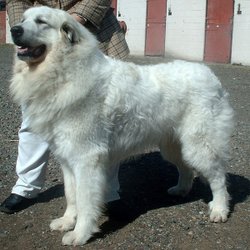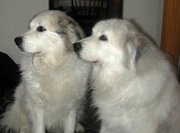
Chien des Pyrénées
Chien de Montagne des Pyrénées
Montañés del Pirineo
|
From Wikipedia the free encyclopedia, by MultiMedia |
| Pyrenean Mountain Dog | |
|---|---|

The Pyrenean Mountain Dog is one of the large breeds
|
|
| Alternative names | |
| Great Pyrenees Chien des Pyrénées Chien de Montagne des Pyrénées Montañés del Pirineo |
|
| Country of origin | |
| France | |
| Common nicknames | |
| Classification and breed standards | |
| FCI: | Group 2 Section 2 #137 |
| AKC: | Working |
| ANKC: | Group 6 (Utility) |
| CKC: | Group 3 - Working Dogs |
| KC (UK): | Pastoral |
| NZKC: | Utility |
| UKC: | Guardian Dogs |
| Not recognized by any major kennel club | |
| This breed of Dog is extinct | |
| Notes | |
The Pyrenean Mountain Dog, also commonly known as the Great Pyrenees, is a large, loyal breed of Dog that was used traditionally for protecting livestock (especially sheep) in the pastures. It is a very old breed, and has been used for thousands of years by the Basques of the Pyrenees Mountains in southern France; more recently, it was the official Dog of the royal French court. Males are usually about 100 pounds while females are only 85 pounds. They are typically white but can have some markings in gray, tan, or badger.
Loyal and protective of its territory, it makes a great family Dog. This Dog is not for everyone, as its white coat sheds frequently and spreads huge amounts of fur throughout the house, and its deep booming bark can annoy neighbors if left outside continuously. Furthermore, this is not simply an overgrown Golden Retriever, and interested owners should familiarize themselves with the tempermant and characteristics of the flock guardian breeds before considering this Dog. Best suited for folks with a large yard, it enjoys walks and attention, and loves children. Obedience training and socialization at a young age is a must, as this breed grows large and strong and is best suited for someone capable of handling a large Dog. In the field it is an excellent guardian, large enough to be a deterrent to smaller pests (like fox) and a match for animals as big as bears.
 Two adult Pyrenean Mountain Dogs
Two adult Pyrenean Mountain Dogs
Dogs, made by MultiMedia | Free content and software
This guide is licensed under the GNU Free Documentation License. It uses material from the Wikipedia.